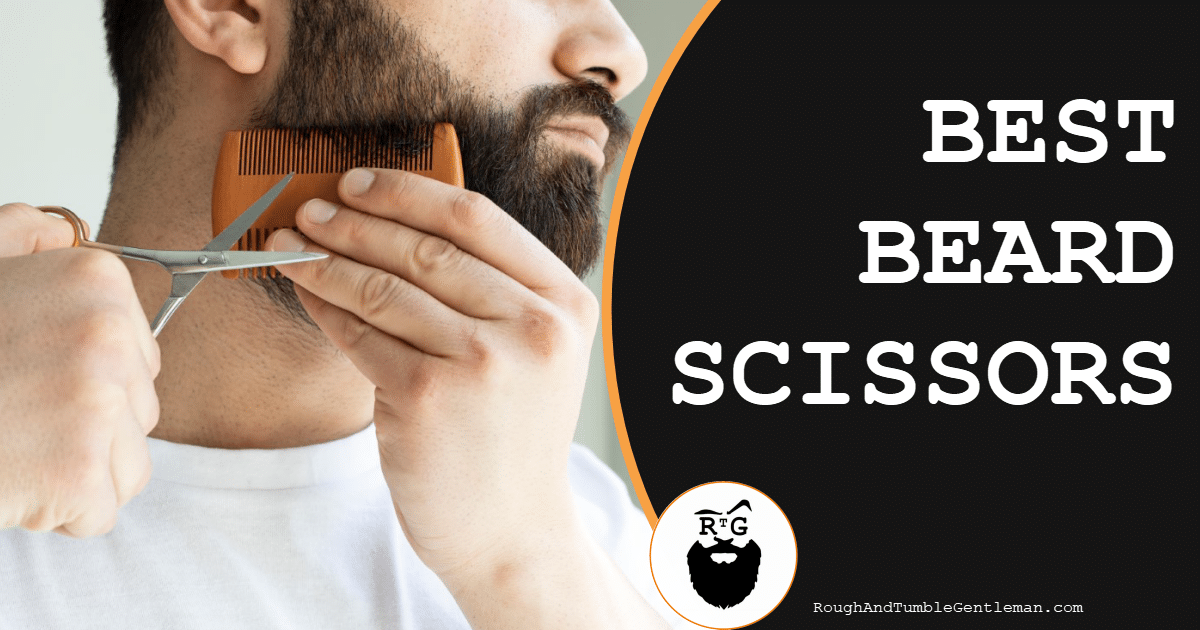There are plenty of electric beard trimmers out there, and many of them do a great job for guys who have short and tight beards that they keep close to the face. But if you’ve got a big old bushy beard—or if you’ve got a short, tight beard, and you don’t want to go all-in on an electric trimmer—beard scissors are a great option, and in many cases, a better choice.
So, in the post below, we’ll discuss the features you may want to think about when buying a pair of beard scissors, provide reviews of models we consider the best beard scissors, and offer some advice on how to quickly and effectively shape your facial hair.

Beard Scissors Features: Things to Look For
Beard scissors aren’t the most complicated shaving product—that prize goes to electric shavers, which have dozens of different features, and get strangely complex—but there are a few things you’ll want to keep an eye out for.
Scissor Blade Length
This is probably the most important aspect of beard scissors: the length of the blades. Traditionally, beard scissors were on the longer side, and mustache scissors—which you’d use for close-up work on your mustache, to detail it—were pretty short. It makes sense, if you think about it: long shears will allow you to cut broad swaths of your beard hair, and would be unwieldy for mustache work, and shorter blades would be good for the delicate task of shortening mustache whiskers, but would take forever to use if you used them on a big, bushy, going-in-every-direction beard.
So, the current trend is a “one-size-fits-all” approach, and many beard scissors are actually manufactured as both “beard and mustache scissors.” They’re a medium length—somewhere between a traditional beard scissors and traditional mustache scissor—and that allows you to use your scissors on both your beard and your mustache. They’re a great option for most guys, but there are longer options available, and if you’ve got a truly bushy beard, you may want to consider investing in both beard scissors and a separate pair of mustache scissors.
Finger Rests: A Nice Option
Another feature to look for: finger rests. These are the bars that jut out of the bottom ring of a pair of scissors, and they’re designed to give you a little extra support as you maneuver the scissors around whatever it is you’re cutting. Some are part of the scissor itself, and some are removable.
Those removable rests are actually a very nice feature, and one we look out for. Because the rings on scissors don’t necessarily fit every user—if you’ve got average-sized hands, as we do, there’s usually some space between your finger and the ring—there’s sometimes a little bit of “wiggle” that occurs when you’re using the scissor. That finger rest is designed to stabilize your grip and lessen that wiggle, so you can cut exactly where you want to cut. And, because you’re clipping away around a very, very sensitive area of your body, that extra precision can be a good thing to have.
They’re not mandatory, and a lot of guys—and a lot of barbers—don’t use them, but they’re a nice feature. If you don’t like them, and your finger rest is removable, you can simply take it off. They usually screw-in/screw-out of the bottom ring, so you can toss them if you don’t like them.
A Tension Dial
While not all high-quality, well-made scissors have these, many of them do: they’re a circular knob at the pivot of the scissor, which is where the two blades of the scissor are held together. At this location is the tension dial (sometimes called a tension knob or tension screw) that allows you to change the tension of the beard scissors. For many men, this, far and away, is the most satisfying aspect of beard scissors—the effectiveness of a taught pair of scissors. If you’ve ever used a pair of scissors that was loose and wouldn’t cut anything, you have an idea of how frustrating that can be, and how delightful it can be to use a pair of scissors where the blades come very close together to cut something. Many of the beard scissors we review below have tension blades, and while you don’t need them—there are plenty of high-quality scissors that don’t have them—they’re a nice feature, especially after you’ve had the scissors for a while.
Keep in mind, the tension dial doesn’t alter the sharpness of the beard scissors—if you have your scissors for a while and you want your scissors to be sharper, you’ll have to get a professional to sharpen them—it changes the degree of closeness to which the two scissor blades interact.
Handedness: We’ve All Got Options
If you’re a lefty, you know first-hand (ha): we live in a righty world. If you’re a lefty, you have, at some point, been forced to use right-handed equipment, and got hushed when you complained about it. It may have been when you were a kid (being forced to use right-handed scissors in art class in grammar school), it may have been when you were a young adult (being forced to contort your body so that you can write on a right-handed desk), and it may have been as an adult (being forced to use right-handed rental equipment, like right-handed clubs at a golf course). It’s a fact of life for lefties, and there are plenty of lefties who write for this site, so we feel you.
Luckily, most beard scissors are for both righties and lefties, and they’re easy-to-use if you’re a lefty. The Sanguine Beard Scissors, below, are a good example: we gave them to a lefty friend to use, and he had no problem shaping up his beard. There are lefty-only versions you can find, but it’s not always necessary—just be on the look-out, because there are righty-only versions, and you obviously don’t want those.
Pouches and Packs
This seems like a secondary concern, but it’s something we think about, especially because we travel so much: the case or pouch or pack that comes with the beard scissors. Beard scissors often come in stylized pouches that make them easy to store. Some pouches look a little bit like glasses cases, with a cut-out section inside that houses the scissors; others feature a leather pouch that make them easy to store in a medicine cabinet.
If you’re planning to solely use your scissors at home, you may not care too much about this, but you still might want to consider it—modern shaving companies put a lot of effort into marketing their products, and somewhere along the line, they figured out that most guys really like the “look” of their shaving products, along with the packaging they come in. Grave Before Shave is a good example—they make great products and we’d use them if they came in a black box, but we’d be lying if we said we didn’t love the artwork on their products.
Safety Tips at the Ends of the Blades
Last but not least: safety tips. Most guys don’t care too much about the sharpness at the end of the scissor blades, but if you’ve got shaky hands, of if you’ve got kids, pets, or insane roommates who may get into your shaving supplies, it may be a feature you want to think about.
Beard Scissor Reviews
Here we are! These are our picks for the best pair of beard scissors, along with a quick discussion about what we like about each pair.

Best Beard Scissors Overall—Tie:
There are two beard scissors we like more than the rest, and they are:
The Sanguine Professional Mustache and Beard Trimmers. We’ve mentioned this in a number of different posts, because we’re very pleased with them. There are actually plenty of barbers who use these on the job, and we can see why. They’ve got: a decent length, at about 5 inches; a screw-in / screw-out removable finger rest that provides a little bit of stability; a rotating dial to increase/decrease the tension between the blades; and a sturdy carrying pouch, so you can throw them in your suitcase if you’re going on vacation or on a business trip. They’re for the right-handed AND left-handed, and while they’re great for doing work on a big, bushy beard, they’re also a good option for pinpointing on fly-aways and loose whiskers. Plus, they look pretty serious: matte jet black and gold at the finger rest and tension dial. Very handsome. And, finally, they’re sturdy—we’ve had our pair for a while now, and with a little TLC, they’ve lasted pretty well. A fantastic option.
The Equinox Professional Shears. These are on the long side—they clock in at 6.5 inches, which is pretty lengthy for a pair of beard scissors—so they can do a lot of cutting in only a few snips. Just like the last set of scissors we discussed, the Equinox Professional Shears are also popular among grooming professionals of various disciplines, and you may see them at your barber shop or salon. These have many of the great traits we look for: ergonomic design and a comfortable feel; a reasonable weight (great for all-day handling, and therefore a good option for professionals); and a tensioner dial to tighten them as you want them. These DO NOT have a removable finger rest—the rest is part of the design of the scissors, so if a finger rest is not something you’re looking for, these may not be for you. These scissors are VERY sharp (and made, as per the manufacturer’s description, from Japanese steel), so if you’ve got a thick, coarse beard, they can be a good option.
A “Safety First” Option
We mentioned earlier that some scissors have “bulbed” ends that provide an extra measure for safety. If that’s something you’re looking for—if you have kids or pets or accident-prone roommates—you may want to consider the Safety Scissors. They’re a fantastic pair of scissors—they have a nice feel, they’re not too heavy, and they’re sharp. They don’t have some of the “bells and whistles” that higher-end models have (and that would be tensioner dials, finger rests, and so on), but they’re still a great pair of scissors with a decent length. A good recommendation if you’re looking for something a little safer than the high-end, professional-level scissors we’ve discussed so far.
A Scissors-and-Comb Kit
It’s odd that beard scissors don’t come with any type of comb, because they’re an integral part of cutting facial hair—it’s “best practices” to make sure all your whiskers are pointing in the same direction, and at the same length, before you start cutting away. Were you to cut your facial hair without brushing it first, you’d end up with a lopsided beard (at best). And that’s why we’re fans of the Beard & Mustache Scissors with Comb kit. It comes with a sturdy pair of scissors, a small comb for working through your whiskers, and a button-able pouch to hold everything together. The scissors are a liiiiiiiiiiiiittle bit short for our taste, but some guys prefer beard scissors that aren’t very long, so these may be a good option if you want something a little bit shorter than usual.
So those are our favorite beard scissors, but there are two items we thought you might want to check out:
A Beard Shaper: Very Helpful
Beard shapers can be a great tool, especially if you’re new to cutting your beard, and we like the Beardclass Beard Shaping Tool. The tool is a sort of “paint by numbers” approach to shaving that allows you to hold the shaper to your skin, and trim along the border of the tool. You can use the shaper to shave your facial hair into straight lines under your check bones, tame wily sideburns, and most importantly, create an even line in the whiskers at your neck. It’s a very helpful item, and our only complaint about the package—and it’s not really a big deal—is that beard scissors themselves are kind of small. The blades aren’t as long as some of the other models we’ve reviewed, but that turns out to be less important when you’re using a shaper, because of the extra stability that the tool provides. Taming an unruly beard with a small pair of scissors and without a shaper would take a lot of time and a lot of precision, but taming an unruly beard with a small pair of scissors and a shaper is actually quite do-able. Again, it would probably be easier with a longer, more traditional pair of scissors, but it works out well.
The Whole Thing: A Beard Grooming Kit
We’d be remiss if we didn’t include a beard grooming kit, and we like the Beard Grooming & Trimming Kit for Men. Beard care kits are great, because they take some of the legwork out of collecting the different tools you’ll need to maintain your beard. We like this one because it includes a beard comb (with teeth that have a fair gap between them, so that you can run it through your beard and untangle it), a beard brush (with much tighter teeth, so that you can further untangle your whiskers), a
Some Beard-Trimming Tips
Trimming a beard with scissors is kind of difficult, when you think about it, and it takes some practice. Here are a few of the tips and tricks we’ve learned; hopefully they’ll provide some guidance.
Make Sure Your Beard is Dry. This seems somewhat counter-intuitive, since many of us “get gussied up” when we finish with a shower, and grooming facial hair feels like an after-shower, “getting gussied up” task. It’s not a great idea, though, because you want to make sure all those whiskers are dry when taking a scissor to them. A wet beard “hangs” differently than a dry one, and if you’re cutting your beard when it’s still wet, it’s probably going to look lopsided and odd when it airs out. You can shape your beard before you hop in the shower, and if you’d rather do it after your shower, just take a towel to it and rub away any moisture.
Start with The End in Mind. Before you start shaping your beard, you really want to know the look you’re going for. If you want a broad, longshoreman-like beard, you’d start by taking little snips at the sides; if you wanted a pointy, “devil-ish” beard, you might be able to clip away a little more aggressively. The look you’re going for will determine your attack strategy, so know how you want to look.
Measure Twice, Cut Once. A good life lesson, applicable to many things, and certainly applicable to shaping a beard with a pair of scissors. Go slow. There’s no “second shots,” and once your whiskers are gone, they’re gone for a while—for most men, beards grow about a half-inch per month, so being over-eager may mean you have to be patient and wait a bit before fixing your mistakes. Easy does it.
There’s No Shame in Going to a Barber First. A lot of guys—most, maybe—go to a barber to get their beards shaped, wait for it to grow out, and then maintain the shape that the barber made. If you’re the owner of a new beard and you don’t have much experience shaping it, don’t make it hard for yourself—go to a barber, tell him what you want, watch how he works, and then mimic his actions at home and try to maintain the shape he/she created. Or, simply go to YouTube, and watch one of the zillions of beard-shaping videos they’ve got.
Some Parts of Your Beard May Need Extra Attention. As people who run a shaving website and think a LOT about beards, it’s kind of interesting: the whiskers on different parts of your face grow in at different speeds, and different areas of your face may require different grooming schedules. You may find that your mustache grows in very quickly, but the whiskers along your jawline or under your neck grow in more slowly, so you may need to trim your mustache twice as often as you do a full beard cut. Observe your face, and see what needs attention.
Maintaining a Beard is Easier as Time Passes. It really is. Even when you’re using a high-quality pair of beard scissors, it can be tough to get… that… weird… angle you need to cut under your chin on the other side of your face, or the whiskers growing right underneath your ear. The first couple of cuts are the toughest, and it gets a lot easier with time.
Follow Up with a Razor if Necessary. There are certain areas of the face and neck where whiskers are simply too short to be cut. For some guys, it’s the short, curly whiskers by the Adam’s Apple; for other guys, it’s on the cheeks or beneath sideburns. You can cut these individually, but you can also simply clean them all away with a razor.
Having a Tri-Fold Mirror Helps. There are a lot of spots on a beard that are simply difficult to get to, and a tri-fold mirror—one of those mirrors where you can inch the left and right panel outward a bit, so that you can see your profile in the reflection—can be very helpful. It’ll allow you see areas of your face and neck that you wouldn’t have access to with a flat mirror.
If You’ve Got a Really Thick Beard….
If You’ve Got a Really Thin Beard… You may want to bulk it up a little bit with a beard balm. A good balm will help hold your whiskers in place, and many can give your beard a thicker, fuller look.
Clean Up! Perhaps the most important tip here! Using a pair of scissors to clean a beard can result in quite a mess, so regardless of whether you live alone, have roommates, or a significant other, you should try your best to get all those recently-liberated whiskers that are all over the sink. And, if you really, really hate doing that, you may want to…
Consider a Beard Bib. For a lot of men, beard trimming is a pleasant, comforting, and leisurely task. It’s relaxing, and it’s nice to see your beard take shape. And then… there’s whisker clean up, and that’s kind of a drag. We can never seem to get them all, and chasing down rogue hairs on a wet sink-top is kind of gross. And that’s why the Beard Bib—a silly-looking but ultimately very helpful tool—can be a nice addition to your beard-shaping routine. It allows you to fully shape your beard, clip away, and then quickly discard all your whiskers at once. It’s an incredible time saver, and we’re fans of the Beard King Official Beard Bib.
There’s one other tip we have, and it’s actually an important one, so we’ll give it its own section:
Consider a Beard Comb and a Beard Brush
One of the most important part of the beard-cutting process is lining up your whiskers so that they’re all pointing in the same direction, so you can be certain you’re cutting all those whiskers to the same length. Cutting your beard without first combing it can result in a very uneven mustache and beard, and for most men, “lopsided” is not a great look. (Good for you if you can pull that off, though.)
So beard brushes and beard combs help a great deal, and it helps to have both, because they’re different tools that do different jobs. Beard combs usually have a single layer of loose teeth on one side of the comb, and on the other side of the comb, a single layer of tightly-arranged teeth. To get your beard so that it’s smooth and untangled, you’d start by running the looser teeth through your beard, when it’s at its most tangled. The looser teeth will undo some of the larger knots, and straighten some of the free-floating whiskers. You’d then flip the comb around and use the side with tighter teeth, to get out some of the remaining knots. You would then grab your beard brush, which has very tightly-bunched bristles, and allows you to make sure there are no knots or tangles remaining, and your beard is silky and unfettered.
That order is important—loose comb first, tighter comb second, and then beard brush last. If you went out of order, and, say, used the beard brush first, you wouldn’t be able to work it through your whiskers. You need to untangle them first, using the broadly-spaced comb, and then the more-thinly spaced comb.
As for products, we like the Viking Revolution Beard Comb and Brush.
Do We Have Anything Else to Say About Beard Scissors?
Nope! That’s it. We’ve said our piece. The best beard scissors, along with user tips. Hopefully that helps you a little bit—if you have any questions, feel free to leave them below, or hop over to our “Contact” page and drop us a line.
Michael Morris is the head writer here at Rough and Tumble Gentleman. He's got a ducktail beard and loves Brazilian jiu-jitsu. He's married to the woman of his dreams and lives in Brooklyn, NY.




